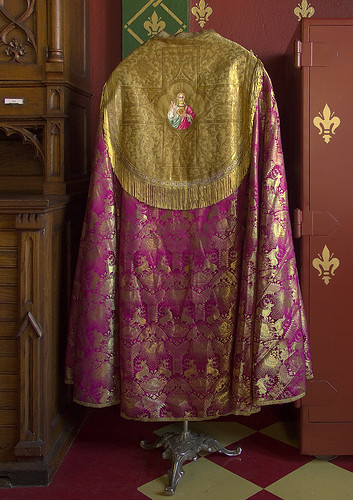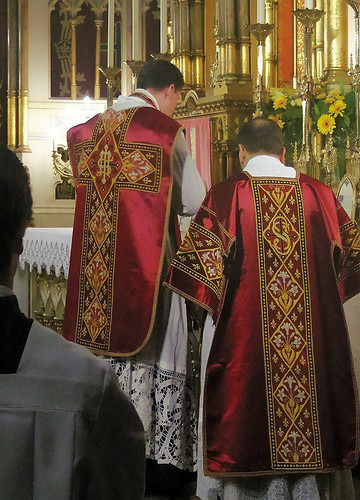This unusual vestment color, optionally worn only twice a year on Gaudete and Laetare Sundays, are for the joyful days in the middle of penitential seasons. That black vestments were formerly worn in these seasons makes this color contrast even greater.
The Latin rosacea is translated as rose-colored, but of course roses can be red, white, pink, or yellow or many other colors in the warm part of the color gamut. So we ought to look closer at history.
Traditionally, textile dyes were made from organic sources, often with little or no special processing. Because of the limited number of natural dyes that were available before the introduction of the first synthetic dye in 1856, we can often quite accurately deduce the precise colors of historical textiles. The bright pink often used as the liturgical rose color probably dates no earlier than the 1960s, when fluorescent dyes were first broadly used.
Rose Madder is an organic dye, made from the root of the madder plant, which was extensively used until its active ingredient, alizarin, was synthesized in the late 19th century. This was the traditional rose-colored dye used since remote antiquity in Egypt. Due to its relative weakness, the use of this pigment was limited to textiles rather than for oil paint.
Here is a sample of a very bright Rose Madder:
And here are vestments used at Saint Francis de Sales Oratory this past Laetare Sunday:
However, Rose Madder dye can produce a pinker color:
In the previous photo, you can see a shimmer of this color on the priest's left shoulder.
Of course, lighter and darker examples can be made from these colors.
A dark pink called Dusty Rose is often seen in traditional rose vestments, as in these, also at the Oratory:


This kind of color was traditionally made by mixing Rose Madder with blue.



Mr. Abeln:
ReplyDeleteI just stumbled across this blog yesterday from a link at the New Liturgical Movement.
I simply had to tell you how amazingly impressive and educational your postings are!
I thank the Lord for the brilliant talent of your photography and your service to His Church!
Dear Rev. Heinz,
ReplyDeleteThank you for your kind words.
Often I think what I write here is "mere straw"; my photos, certainly, are just derivative of the work of real artists!
May God bless you,
Mark
But I do thank for your compliments!
ReplyDeleteHi Mark--
ReplyDeleteI am a novelist living in Iowa City, Iowa. (Yes, we're flooded now, but the flood's east of us. The yard's pretty squishy, though.) I am contracted for a novel,
WIDOWS & ORPHANS, with Algonquin Books of Chapel Hill and Jonathan Cape (Random House UK).
My editor, who has included many of my Catholic stories in her anthologies of the year's best of the South-- I grew up in very Catholic New Orleans and was taught by the School Sisters of Notre Dame, whose Motherhouse is in St. Louis--
stumped me recently when she said she had NO IDEA what devotion to the saints means. She had
published LOTS of my stories that deal with the saints.
So at present I'm trying to do more exposition in some of my narrative. I was looking for the origin of the pink vestments for Laetare and Gaudete Sundays, and I stumbled on your blog. Thanks.
If you want to see my work, google my name plus my first novel's title, URSULA, UNDER. I don't think this belongs in your blog, though.
Best,
Ingrid Hill